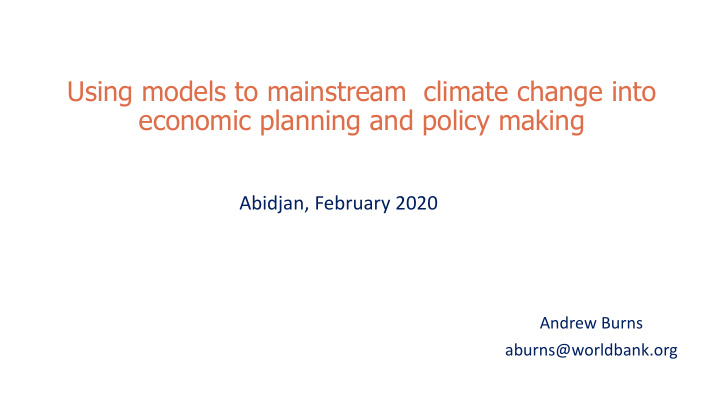



Using models to mainstream climate change into economic planning and policy making Abidjan, February 2020 Andrew Burns aburns@worldbank.org
Climate-aware macroeconomic models help quantify both direct and indirect effects Program objectives: • Make country-level climate-aware macroeconomic models more available and user-friendly • Provide Ministries of Finance, Planning Economy with a consistent way of looking at and evaluating alternative CC policies alongside other policy priorities of the government (i.e. climate, vs labor market vs education or infrastructure) • Help to integrate climate-change outcomes and considerations into the day-to-day decision making of whole-economy ministries
Evaluate climate’s effect on the economy, and the economy’s effect on climate • Damages: Higher temperatures, changing weather patterns & more extreme weather, reduce productivity, destroys capital, and generates structural change • Adaptation: Infrastructure hardening, improved water management, public-sector cooling solutions can limit negative effects • Mitigation: Taxes, subsidies, sectoral and transport policies all affect carbon intensity and GHG emissions • Models are a work in progress
Model allows quantification of indirect benefits Cost of Macrostructural models allow for climate • comprehensive policy • consistent • general equilibrium comparison Direct Lower climate Revenue Net cost of climate cost damages recycling Co-benefits policy may be negative! Examples:
Recent and ongoing climate ware modelling projects Macrostructural CGE • St. Lucia • Pakistan • Jamaica • Vietnam • Argentina • Indonesia • Pakistan • Cote D’Ivoire • Uganda • Colombia • Kenya • Uganda
A concrete example: Reduce emissions in a developing country • Reduce GHG via carbon taxation (Introduce $50/ton Carbon tax in 2025) • Alternative scenarios: use fiscal revenues from carbon tax to: 1. Lower deficit / debt, which will reduce interest rates and stimulate investment and growth 2. Increase revenue mobilization / government expenditures proportionately 3. Increase revenue mobilization / emphasize investment 4. Increase revenue mobilization / emphasize transfers to offset impacts
Impacts on GDP Per cent deviation from baseline Investment weighted scenario 1.0 Household transfers 0.5 0.0 GDP responds -0.5 Proportional spending increase strongest when -1.0 carbon tax revenue is recycled toward -1.5 investment spending. Debt reduction scenario -2.0 -2.5 -3.0 2020 2025 2030 2035
Impacts on Consumption Per cent deviation from baseline 1.0 0.5 0.0 Household transfers -0.5 Impacts on households, -1.0 best measured by real -1.5 Investment weighted scenario consumption. -2.0 -2.5 Household transfer -3.0 scenario has least negative -3.5 Proportional spending increase effect. -4.0 Debt reduction scenario -4.5 2020 2025 2030 2035
GDP and household welfare are not the same thing Per cent deviation from baseline 1.0 GDP – Debt reduction scenario 0.0 -1.0 Household Consumption – Debt reduction scenario In debt repayment scenario, -2.0 GDP rebound more strongly, due to higher investment. -3.0 Higher prices weigh on household welfare/ -4.0 consumption. -5.0 2020 2025 2030 2035 GDP HH Consumption
Impact of $50 Carbon tax (after 10 years): Alternative tax recycling scenarios Carbon Emissions GDP Consumption GG Bal. GG. Debt 0 4 2 -5 0 -10 -2 -4 -15 -6 -20 -8 -10 -25 -12 -30 -14 Debt repayment Revenues spent on: Proportional Increase in gov’t spending Incrs Gov’t (focused on investment) Incrs Gov’t (Focus on transfers)
Summary of results after 10 years Scenarios Debt Proport Invest Transfers Reduction Exp weighted weighted (% change from baseline) GDP 0.1 0.5 0.8 0.0 Consumption -2.5 -2.0 -1.7 -1.1 Investment 0.5 2.8 4.9 -0.1 Exports 1.0 0.1 0.1 -0.2 Imports -7.7 -4.9 -4.5 -4.7 (Change as a % of baseline GDP) Current Account 1.1 0.3 0.3 0.3 Gov't revenues 0.8 1.6 1.7 1.7 Gov't Balance 1.5 0.4 0.5 0.5 Gov't Debt -12.3 -2.4 -2.6 -3.3 (% change from baseline) Emissions -26.7 -24.7 -24.5 -24.3
Recycling of carbon taxes impacts on formal vs informal sector % change in value added from the baseline 2.0 HH Transfers 1.5 Formal Prod Tax Reduce taxes on formal labor 1.0 VAT reduction 0.5 0.0 In this country formal sector is much more carbon intense so is harder hit in all scenarios. -0.5 Production taxes mainly hits formal sector so -1.0 reducing taxes on formal economy offsets most negative effects -1.5 Formal Sector Informal Sector
Easy-to-use whole-economy models help mainstream climate into economic decision making • Allow Finance, Planning, Environment Ministries to evaluate with consistent framework the economy-wide effects of climate action (or inaction ) • Climate impacts: (GHG emissions; climate related damages to productivity infrastructure, health) • Fiscal impacts (revenues; resource mobilization; expenditures; debt; debt sustainability;) • Growth effects (productivity impacts from higher temperatures; pollution; reduction of highly distortionary taxes) • Social impacts (replacement of subsidy of fuels with targeted transfers; impacts of alternative use of CC policy revenues – transfers to the poor, extension of high-impact social policies) • Help quantify the costs, benefits and co-benefits between climate and fiscal policies including spending and tax policies that are not explicitly climate- oriented
Recommend
More recommend